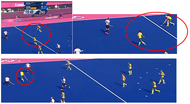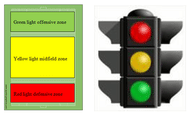Example 2: During the 2014 WHL Finals, semi-final match between Australia and Netherlands, an Aussie player with the ball did not read the game situation and optimize the application of soft skills while slowing down, which resulted in the first goal being scored against his team. See the following sequence of photographs:
Photo 3 and 4: Turn over and counter attack is launched.
Photos 5, 6 and 7: The Dutch forward takes the try and scores the first goal of the match.
Example 3: I am not trying to beat a dead horse or annoy my friends from Down Under, who have taught me a lot as a coach. But during the 2012 London Olympic Games semi-final match between Australia and Germany, the Aussies made an unforced error in the nearby zone, as in the first two examples. This may be due to the fact that they took recognising/recalling patterns of play lightly, or perhaps because of miscommunication or misunderstanding, but the naked fact is that it snatched the Olympic gold medal from their reach. The Aussies were leading 2-1 in this crucial match with less than 20 minutes to go. The Germans won the match 4-2 and eventually the Olympic Gold medal, too.
Here are the photo sequences of this specific game situation.
Coaching tip to cope with different game situations in different zones of the field
There are different moves – dodges – for every position, zone and situation on the field. One size does not fit all. For example, the dodges – moves – of the right full back or right inner on top of one’s circle are different from those, when they are on top of the opponents’ circle. There is a day-and-night difference in these 2 game situations, from the tactical thinking point of view and the key decisions to be made. This is one of the aspects of the game – insight – in which our coaches have not been able to make the same degree of improvement as was envisaged. We lack clear conceptual understanding, with regard to the specific soft skill dodges/moves to be implemented in given situations.
When we closely compare and dissect the above three Aussie examples under a microscopic eye, it would be clear that they are more or less in the same specific zone of the field and of a similar nature. It seems like the Aussies underestimated the potential dangers of taking a risk in this red light defensive zone. It was a judgemental error in reading the current game situation and not knowing which dodge or move to employ in it and why. And this, from world class players possessing supreme skill-sets. By the way, and I see things like this happening over and over, from the sticks of the other world class players/teams too. Strange but true!
A good way to remember the various zones of the field is to refer to the analogy of the traffic lights at an intersection. One can right away see the red light and correlate it to the red light defensive zone of the field. Slow down and switch gears while lifting the foot from the gas pedal to plant it softly on the brakes.
Importance of soft skills
With their lack of in-depth space awareness, inability to recognize the instant changing game patterns and unawareness of the “historically important, tactically-rich offensive gold mines or defensively dangerous landmines”, the current generation of players/coaches are missing a point which has affected our game. Do you think we – players and coaches – are deliberately ignoring the above points, or that we don’t know about them and are ignorant? Hard to say, you be the judge!
Embrace the soft skills
It is obvious that a majority of the players from the current generation have not been introduced to soft skills, especially possession skills – ball control – in a close range situation under pressure. No doubt they have mastered the hard skills, but in the absence of soft skills, they are falling short significantly. The specific areas which need to be improved are:
- Footwork with the ball
- Stick work and stick feints
- Deception and body feints
- Dexterity
- Knowing the silky soft moves to implement in various tight game situations








